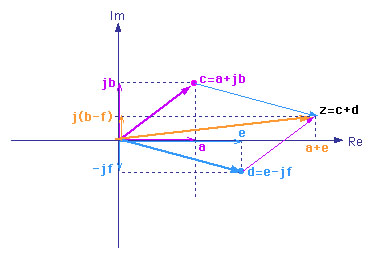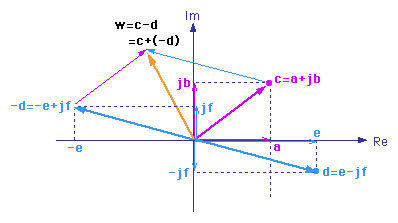 . (Physicists use i in place of j).
. (Physicists use i in place of j).
The building block for complex numbers is  . (Physicists use i in place of j).
. (Physicists use i in place of j).
A complex number is represented by:
c=a+jb
Here a is the real part of c (Re(c)) and jb is the imaginary part of c (Im(c)).
The complex number c is represented on a two dimentional plane as a point as shown in the Figure below.

The Abscissa is the Real-axis and the Ordinate is the Imaginary-axis. The projection of c on the real axis is a and the projection of c on the Imaginary axis is jb
The complex number c can also be written as

Here |c| is the Magnitude of c and f is the Phase-angle of c with respect to the Real axis.
Complex Conjugate of a complex number is defined as
c*=(a+jb)*=a-jb
Here the imaginary part is replaced by it's negative.
The real and imaginary parts of the two complex numbers are added.
Example:
Given:
c=a+jb
d=e-jf
z=c+d = (a+jb) + (e-jf) = (a+e) +j(b+(-f))= (a+e) + j(b-f)

The real and imaginary parts of the two complex numbers are subtracted.
Example:
Given:
c=a+jb
d=e-jf
w=c-d = (a+jb) - (e-jf) = (a-e) + j(b+f)

This can also be thought of: adding to c, the negative of (d)
Given:
c=a+jb
d=e+jf
w= cd =(a+jb)(e+jf) = ae +jaf +jbe + (jb)(jf) = ae +jaf +jbe + j2(bf) = (ae-bf)+j(af+be)
Here j2=-1 is used.
Given:
c=a+jb
d=e+jf

The numerator and the denominator are multiplied by the complex conjugate of the denominator, both denominator and the numerator are then multiplied using the rules for complex number multiplication and the real and imaginary parts are seperated.
The multiplication can also be carried out using the magnitudes and the phase angles. The magnitide of the numrator |c| is divided by the magnitude of the denomintor |d| and the phase angle of the denominator f2 is subtracted from the phase angle of the numerator f1.